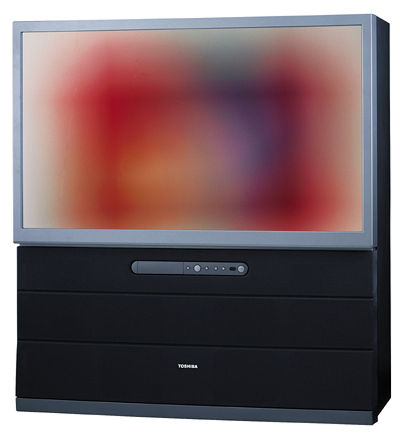Toshiba 50H81 HD-Ready 16:9 rear-projection television
Once Around the Block
As with earlier Toshiba widescreen models, the 50H81 provides several aspect-ratio options: Standard places normal 4:3 program material in the center of the screen, left to right, and adds gray bars at the sides to fill the remaining space. These bars do minimize the risk of burn-in, but some viewers find them distracting. There are three widescreen settings: TheaterWide 2 provides the correct proportions for non-anamorphic, letterboxed films, and TheaterWide 1 and 3 expand 4:3 material to fill the screen and eliminate the gray bars. The stretching required to do this inevitably distorts the image slightly. I found TheaterWide 1 tolerable for casual TV watching (it expands the picture more at the sides than in the center), but, as with any such compromise, individual reactions will vary widely. The last aspect option, Full, stretches the picture for correct playback of anamorphic (enhanced for widescreen) DVDs.

There are other familiar features I won't dwell on here: a selectable option that places two sources side by side on the screen, a line input that lets you use the TV's sound system as the center-channel (the set's own sound system is okay as these things go, but we don't recommend using it for serious home-theater center-channel use), three color-temperature settings (none of them very accurately calibrated out of the box), program blocking using V-chip control, a Film setting of the Cinema Mode that's said to provide 3:2 pulldown recognition from the onboard line doubler, and a number of other features—Automatic Light Sensor, or ALS, which varies contrast with room lighting; (auto) Flesh Tone; SRS 3D "surround sound," using only the set's two built-in speakers; and Dynamic Noise Reduction (DNR)—that are best used sparingly and only with non-critical sources, if at all.
The 50H81 offers three forms of convergence adjustment. New is the Touch Focus feature, which automatically tweaks the convergence (not, strictly speaking, the focus, though convergence can definitely affect the image's subjective sharpness). This one-button solution works surprisingly well, though not perfectly, for those who break out in a rash at the thought of any technical dabbling more complex than point-and-click. The other two convergence modes are carried over from earlier Toshiba models: a service-level adjustment and a nine-point user convergence. After I tweaked the convergence several times using the service-level adjustments, it remained relatively stable.
The Toshiba displays a 1080i source directly. It will not display a 720p input; you'll have to convert it first to 1080i (most HD tuners do this) before routing it to the set's inputs. A standard-definition, 480i interlaced source is converted by the set's built-in scaler to 540p, not 480p. A 480p input, as from a progressive-scan DVD player, is not displayed directly but is instead converted by the set's built-in scaler to 540p. Several manufacturers have gone this route, not because 540p provides more lines, but because it simplifies a set's design: only one scanning rate—and therefore one factory calibration—is needed (540p and 1080i use the same scanning frequency).
In a number of early-generation HD sets the displays would lock into anamorphic mode whenever they sensed a 480p input. With such a set, 4:3 and conventional non-anamorphic, 480p material could not be displayed with the proper geometry. This design limitation is becoming less common, but it's still worth checking before you buy any HD set, if you ever plan to use an external line doubler or a progressive-scan DVD player. Toshiba sets have never had this limitation; the current models continue to provide full aspect-ratio control with 480p sources.
Because there are small differences in the optimum color decoding for DTV and DVD, earlier Toshiba DTVs provided a menu selection to set up their component inputs (Toshiba calls them ColorStream HD) to one or the other of these sources. The 50H81 omits this option. While I would prefer they hadn't done so, I nevertheless had no reservations about the color reproduction of either source after calibration.
- Log in or register to post comments
























































